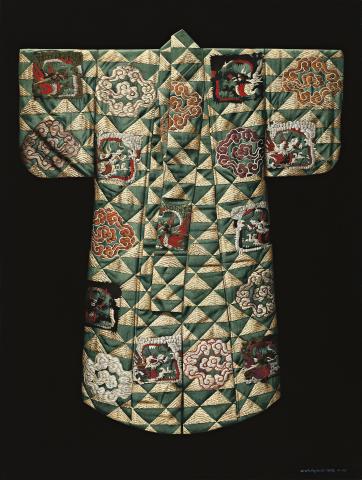KIMONO, 1991 – 1998
WILLIAM DELAFIELD COOK
synthetic polymer paint on canvas
122.0 x 92.0 cm
signed and dated lower right: W Delafield Cook 91-98
Gene and Brian Sherman collection, Sydney
Hart, D., William Delafield Cook, Craftsman House, Sydney, 1998, pl. 108, p. 209 (illus.)
‘By giving what is commonplace an exalted meaning, what is ordinary a mysterious aspect, what is familiar the impressiveness of the unfamiliar, to the finite the appearance of infinity...’1
Hailed the quiet hero of Australian art, William Delafield Cook is one of those rare few artists whose works have entered public and private collections almost as soon as the final brushstroke has dried. Whether immortalising a carefully constructed pyramid of haystacks, the subtle nuances of the intractable Australian bush, or ancient relics in one of Europe’s hallowed art museums, undoubtedly fundamental to the widespread appeal of Cook’s art has been his unique ability to produce tantalisingly real images of meticulous, near photographic exactitude. Imbued with a haunting air of stillness, his immaculate images reveal not only a fascination with the illusory possibilities of paint and mankind’s attempt to civilise nature however. More importantly perhaps, they explore the artist’s deeply felt awareness of our own mortality – a sense of time as immeasurable against the acute poignancy of our short lives. As he astutely mused, ‘I’ve long seen the world as a series of theatre stages. We players move in and out but the world endures long beyond us.’2
The antithesis of the Impressionist who seeks to capture the transient, fleeting effects of light, and utterly unlike the Expressionist who filters observations through his or her own – usually tortured – subjectivity, Cook aspires rather to an art that is timeless, objective and monumental. Paying homage to the past - from classical painting and architecture through to Romantics such as Friedrich and Surrealists including de Chirico and Magritte – his works speak at once of quietude and magnitude, amplifying small, barely detectable sensations to the level of grand history painting. Thus transcending the descriptive to offer something more metaphysical and speculative, Cook’s compositions capture not so much instances of time, but time immemorial, exploring eternal problems and experiences that pervade all humanity.
Belonging to the important series of works undertaken by Cook during the late 80s and 90s around notions of transience and impermanence, Kimono, 1991 – 1998 is an exquisite example of this quest for an underlying universal truth. Inspired by natural phenomena and objects discovered in museum collections across Japan, Paris, London and Australia, the series skilfully interweaves not only art and life, but past and present – the depicted objects resonating with history, simultaneous with contemporary life. Although visiting Japan several times en route to and from Australia, significantly it was the displays of kimonos at the Victoria and Albert Museum, London which provided the visual source for his treatment of the subject here. Featuring the vibrant garment with its intricate decorative pattern of arabesque and dragon-like motifs juxtaposed against a dense black surround, the work exudes an unmistakable sense of the theatricality, stillness and detachment so characteristic of the museum environment and as such, encapsulates superbly Cook’s abiding preoccupation with the idea of a work of art as the subject for a work of art – ‘I wanted to celebrate something that is celebrated already. It’s in a museum, spot lit, a source of wonder and delight. I wanted to add a dimension to that…’.3 More universally perhaps, Kimono also suggests another level of consciousness, highlighting the subjective nature of perception and inviting the viewer to observe not so much the object depicted but the ‘essence’ of the object; as Cook himself elucidates, ‘You stare at this thing with a sense of awe. It might not be the actual thing, but there is a label beside it that tells you it is. Our intensity of response is dependent on the fact that we are prepared for it to mean something. We project meaning onto it, investing it with significance by how we respond to it…’4
1. Quote from Novalis, Poeticism (1798) inscribed in one of Cook’s notebooks; see Hart, D., William Delafield Cook, Craftsman House, Sydney, 1998, p. 220
2. Cook, W.D., cited in Field, F., ‘William Delafield Cook: Artist hailed as one of Australia’s finest whose monumental canvases depicted the rugged landscape of his native land’, The Independent, London, 13 May 2015
3. Cook, W.D., cited in Hart, op.cit., pp. 206–207
4. Cook, W.D., cited ibid., p. 213
VERONICA ANGELATOS
